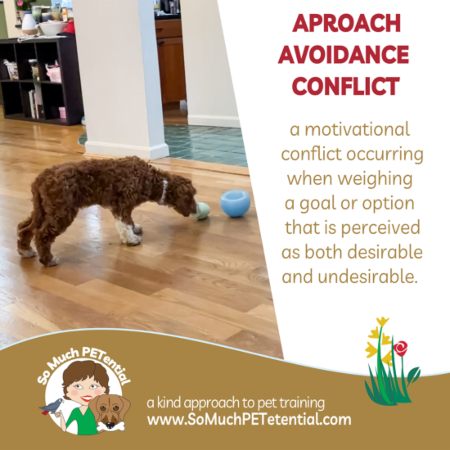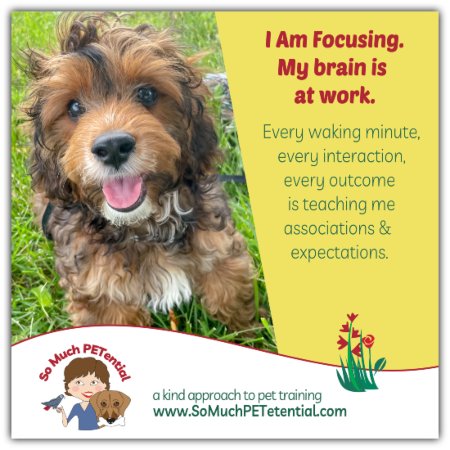The importance of crate training puppies comes up a lot with clients as it relates to house training, teething and setting the puppy up for success. It just happened again the other day. When out of his crate, the adorable little fur ball has a lot of freedom to run through the house – scampering away from people, getting under things, chewing on carpeting or furniture legs, pottying around the corner. He also gets under walking feet, becomes bitey and zoomy when he is overstimulated or over tired.
A puppy has huge needs for exercise, chewing, mental stimulation, eating, pooping AND sleeping. And he is constantly learning from his environment and past experience what behaviors work to get those needs met. Those behaviors that work…will continue. For the good and the bad.
This is why schedules, management, consistency in teaching feedback, and enrichment are such an important part of raising a puppy to grow up with what people call ‘good manners’ and to learn that listening and paying attention to the cues of people.
Without schedules, management, consistency in teaching feedback, and enrichment puppies will have no problem coming up with their own ways for solving their needs and wants. And people do not usually like those choices. Now or in the future.
When I brought my little boy Dawson home, one of the very first lessons I wanted to teach him was that the crate was a great place to relax and nap. (For other first lessons, please see this post.) Little did I know at the time how even more important that lesson would prove to be for us later in his life, as he really needs that place of quiet solitude when he gets sensory overload. It doesn’t happen as much any more thanks to his medication, but it does still occasionally happen.
If you have just welcomed a new puppy into your household, there is no better time than the present to begin teaching your puppy that lesson.
Since a young puppy needs so much sleep (between 17 and 20 hours a day) anyway, he might as well nap in his crate and be conditioned to seeing it as a positive, restful, safe place.
Importantly though is your taking the time to spend teaching this – not simply putting your puppy in there to just get over his fear/anxiety of being locked in a cage away from his humans.
While I play crate games to teach puppies positive associations with going into the crate, I also like to wait until I know a puppy is very tired and in need of sleep to put him in the crate. Then sit with him, calmly giving treats until he is fast asleep. Using a webcam with a phone application will allow you to watch the crate from another location to make sure your puppy continues to sleep or if your puppy wakes up, then you can walk back into the room, letting him out before stress sets in. If your puppy begins barking/jumping as you approach the crate, spend time teaching your puppy that sitting or laying down gets crate doors to open.
There are so many benefits to using a confinement space like a crate.
Among them:
When confined in a crate (with a chew toy or napping), your puppy is learning to settle.
When confined in a crate, your puppy can get the needed amount of sleep/rest he needs for his growing body. If not in a crate, probably your puppy will move around with you as you walk from room to room.
When confined in a crate, your puppy is not making behavior choices you do not want him to make like chewing on furniture, drapes or shoes.
When confined in a crate, your puppy will not pottying in different locations around your home.
For those times when your puppy is out of the confinement area:
That should be time for ACTIVE supervision. This means that your puppy is close to you, either interacting with you or engaged with another acceptable activity like working on a food dispensing toy or sniffing game. I will talk more about what active supervision looks like in a future article.
Remember, training in positive ways, scent work, and socialization is all tiring stuff for young developing minds (and any age, really). So, engaging your puppy in these things will cause your puppy to need and value rest…a great time to be back in a crate…and time for you to get what you need to get done.







